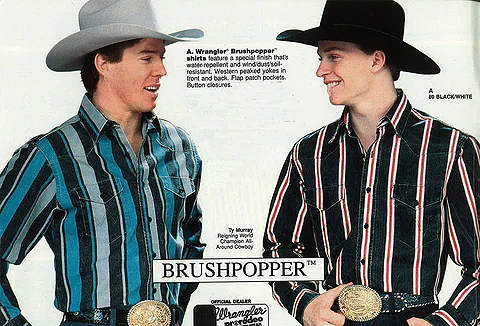
The Story Of The Brushpopper
Long before it was a shirt, “brush-popper” was a cowboy’s nickname. It meant the hand who’d dive into thorny mesquite and cedar to flush out cattle—gritty work that called for grit in the man and toughness in his gear. Wrangler tipped its hat to that spirit in 1979, launching the Brushpopper shirt: heavy cotton for the hard jobs, bold colors for the good times.
If you’ve ever donned true Western wear, you know there’s more to it than fabric—it’s stories stitched into every seam. Take the Wrangler Brushpopper for instance: a shirt, a name, and a nickname all wrapped in cowboy soul.
Where the Name Came From
Out on the brush country—mesquite, cedar, and chaparral—you’d find cattle hiding under every thorn and tangle. The job of wresting them out fell to the brush-popper, a cowboy unafraid of a little grit and thorns. The name was literal, born from pushing through the brush to herd cattle back where they belonged. This term’s been part of real Texas lore since at least the early 1900s, and even J. Frank Dobie mentions it in a 1941 recording.
Fitting name, right? Because that’s exactly who’d wear a shirt strong enough to face the brush and look good while doin’ it.
The Shirt’s Western Runway: From Ranch to Rodeo
Wrangler took that brush-popper grit and wrapped it in fabric in 1979, launching the Brushpopper shirt. It was built for the rodeo—heavy-duty cotton tough enough for daily wear, even through a tumble or two.
The stage was set: striking Southwestern prints turned heads in rodeo stands and honky-tonk bars. This ain’t just a working shirt. Come the late '90s, the original line retired around 2003, but the legacy lingers in western wardrobes and vintage collector’s chests.

What Makes a Brushpopper a Brushpopper
It can be hard to distinguish a Brushpopper from other Wrangler shirts, and the fact that many vintage-sellers are often calling shirts "Brushpoppers" even when they ain't, doesn't make things any easier for the person lookin' for one. Also causing mixups, Wrangler used to label some Brushpoppers clearly with a text "Brushpopper", but some they didn't, so you can't really trust the tag either.
There are a few crystal clear characteristics you should keep an eye on when determining whether a shirt is a Brushpopper or not:
-
Heavy cotton – not dainty denim, but stout 100% cotton made for mesquite tangles. It is way thicker than your average western shirt. Most of them have also been waxed for water-repellent qualities. Then again, not all of them have been waxed, and even if they were, they might have lost the wax after multiple washes over the years. So don't get stuck on the wax.
-
Regular buttons, not snaps – because when you’re bustin’ brush, snaps can pop faster than your rope can. This is a clear indication of a Brushpopper: none of them ever had snaps like most of the "regular" western shirts do.
Other features that were common, but not necessarily an imperative for all Brushpoppers:
-
X-Long Tails – printed on the tag for a reason: extra length to stay tucked through everything from fence-mending to pick-up dancing.
-
Single-Needle Tailoring – true craftsmanship where each seam is stitched one side at a time, making flat, durable seams that feel as good as they look. Brushpoppers were high quality shirts, and extra attention was given to making them.
-
Pocket-flap artistry – clever pattern work where the front yoke flows right into the chest pocket flap. It’s understated, but it shows someone was payin’ attention. (You can see this detail in close-up photos on vintage listings.)
Why They Still Matter
These shirts carry more than fabric. They carry a history, softened and shaped by decades of wear—the brush, the buckle, the barstool. Put one on, and you’re carrying a bit of that authenticity with you.
The Wrangler Brushpopper is more than a shirt—it’s history buttoned tight with single-needle care. Named for cowboys who popped cattle out of brush tangles, born in 1979, and kept alive today by Western heritage fans, it’s a piece of the range, stitched into style.
Check here, if we have any vintage Brushpoppers in stock right now.
